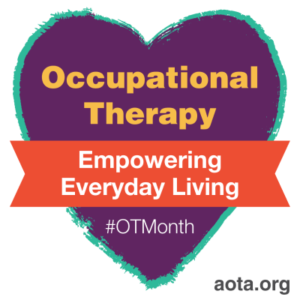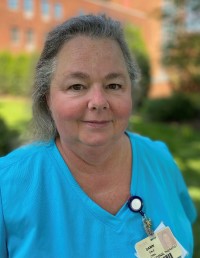
Special to Iredell Free News
After an accident, surgery, or illness, you may need some help getting back into the swing of daily life.
While physical therapy can help you get up, move, and walk, occupational therapy can help you get back to the little things you may not even think about — from getting dressed, to eating, to cooking, or even brushing your teeth.
An occupational therapist helps patients improve, recover, and develop the skills needed to participate in their day-to-day activities.
Occupational therapy (OT) can help people facing a wide range of health challenges. For example, it can help those with arthritis protect their joints by performing tasks differently or help stroke survivors learn new ways to do daily tasks.
The role of an occupational therapist is essential; yet sometimes, it can be difficult for patients to understand.

As part of Occupational Therapy Month, Dawn Dale, an occupational therapist at Iredell Health System, explains her role and sheds some light on the often misunderstood profession.
Dale has been an occupational therapist for 35 years, spending 22 of those at Iredell. She was initially drawn to OT when she volunteered with her father, a special educator at a state facility.
Dale volunteered with occupational therapy and physical therapy, but she ultimately decided OT was a better fit for her.
“I felt it was more function and detail-oriented,” she said.
After finding her passion, Dale completed her education and became an occupational therapist. At Iredell, she works with patients in both acute care and skilled nursing.
In acute care, the majority of Dale’s patients have neurological disorders, orthopedic issues, or have just had surgery.
“For orthopedic patients, I provide them with the special adaptive equipment they need before going home,” said Dale.
This adaptive equipment — such as sock aids, dressing sticks, reachers, and long-handle bath sponges — can help patients be more independent and improve their quality of life after leaving the hospital.
While OT in acute care is normally for a short period of time, therapy in skilled nursing is typically longer-term.
“In skilled nursing, therapists help patients get ready for the next level — whether that’s long-term placement, assisted living, or going back to living at home,” she said. “We practice bathing, dressing, getting to the restroom, getting in and out of bed, and all the other things someone has to do to get through a day.”
In addition to hospital settings like skilled nursing and acute care, occupational therapists may also work in school settings, home health, rehabilitation centers, or mental health facilities.
Along with hands-on rehabilitation, Dale admits some of the most significant help occupational therapists provide is support, allowing patients to vent and express themselves.
“I enjoy OT because it is one of the few disciplines where practitioners are trained to provide emotional support. We have biopsychosocial training that is unique to OT,” she said.
“When you’re used to being independent and suddenly you have a massive stroke or hurt your hip and can’t walk, it’s frustrating. If patients can safely vent about that, it’s easier for them to get to the next level of their therapy,” she said.
Common Misconceptions of OT
When Dale enters a patient room, she says that, oftentimes, patients will hear the word “occupation” and automatically associate it with their jobs or careers.
“I often hear, ‘I’ve already got a job’ or ‘I’m retired. I don’t need a job,’ ” said Dale.
However, occupational therapists define occupation as the activities of daily life. It’s simply the way you “occupy” your time.
“Whatever activities you do during the day is your occupation. Whether that’s going to the bathroom, getting dressed, cooking, or eating, among many others,” she said.
Another misconception is that OT is most helpful for older adults. However, people of all ages can benefit from OT.
An occupational therapist may help children with autism to socialize, show kids in wheelchairs how to play with peers, or help babies and toddlers meet developmental milestones.
Dale also finds that patients sometimes confuse occupational therapy and physical therapy. A physical therapist focuses on mobility and quality of gait, while an occupational therapist focuses on everyday skills.
“I often say, if you go home and want to go to the grocery store, you can move and walk but are you going to go without clothes or shoes on? I feel like a lot of the time patients do not fully understand what we do. When you get them thinking along those lines, they begin to think, ‘maybe I do need that,’ ” said Dale.
“We are trained to teach you techniques and shortcuts that will make activities in life easier, even though you may not even think about them now,” she said.
Iredell occupational therapists and physical therapists work hand in hand. They take a holistic perspective, focusing and tailoring their care plan to each patient’s own needs and preferences.
The Iredell OT team helps patients with goals that matter to them, getting them back to their own “normal,” whether that’s driving, socializing, or practicing hygiene, among many other activities.
OT is an evidence-based practice deeply rooted in science which helps people of all ages and with various needs.
“It’s the little things in OT that I find fulfilling. It’s the patient who all of sudden can put a shoe on and the small things that make their life better. I find the ability to have an impact on people’s quality of life is most rewarding,” said Dale.
About Iredell Health System
Iredell Health System includes Iredell Memorial Hospital; Iredell Mooresville; Iredell Home Health; Iredell Wound Care & Hyperbaric Center; Community and Corporate Wellness; Occupational Medicine; the Iredell Physician Network and more. Iredell Memorial Hospital is the largest and only nonprofit hospital in Iredell County. The comprehensive healthcare facility has 247 beds; more than 1,700 employees; and has 260 physicians representing various specialties. Centers of excellence include Women’s and Children’s; Cardiovascular; Cancer; Surgical Services and Wellness & Prevention. The Health System’s newest campus, Iredell Mooresville, is home to the area’s only 24-hour urgent care facility, as well as an ambulatory surgery center, imaging center, rehabilitation services, and physician practices. The mission of Iredell Health System is to inspire wellbeing. For a comprehensive list of services and programs, visit www.iredellhealth.org.



